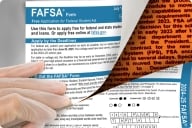You have /5 articles left.
Sign up for a free account or log in.

Twenty-nine percent of all students, 48 percent of Black students and 39 percent of Latina students would receive both the existing Pell Grant and a wealth-based Pell Grant if a report’s new financial aid plan were to become law.
LumiNola/E+/Getty Images
As concerns about college affordability and the economic burden of student loan debt grow, some experts say it might be time not only to boost the budget for federal financial aid but also to go back to the drawing board on how that aid is allocated.
Currently, the federal government awards the Pell Grant to students based on their family’s income and household size, but the formula doesn’t heavily take into account a family’s wealth—assets like college savings accounts, income-producing properties, investment funds, stocks and bonds.
That means that families with higher wages but lower wealth might not be eligible for the Pell Grant at all or receive insufficient financial aid. So they have to take out student loans to pay for college, which has only fueled racial inequality and a growing wealth gap. Historical policies and current data both show that the families who fall in this category are disproportionately Black, Latino and Indigenous.
“There [have been] a number of racially biased policies around housing, employment and education that meant Black families couldn’t access the same kind of wealth as white families,” said Laura Hamilton, a professor of sociology at the University of California, Merced. “If you have governmental aid systems that are mostly targeting income, you’re missing the single largest form of inequality in the U.S.”
But Hamilton and her team at the Higher Education Race and the Economy (HERE) Lab are looking to change that. In a report released Wednesday with support from the Institute for College Access and Success (TICAS), Hamilton outlines a plan for a new, supplemental wealth-based Pell Grant that that would increase the overall amount of federal aid and target those newly added funds directly toward students from low-wealth backgrounds. They envision it as a front-end solution to the student debt crisis.
Although opinions are mixed on whether the proposal is practical, feasible or effective, experts generally agreed that the HERE Lab’s research starts an overdue conversation about how wealth can affect access to college, particularly for underrepresented students.
To determine who would qualify for the new wealth-based Pell Grant, HERE proposes using existing data on family assets collected via the Free Application for Federal Student Aid, which includes almost everything but home equity and retirement funds. Students with a familial wealth of $500 or less would be eligible for an additional $7,395, which is the current maximum Pell Grant award, so the plan essentially doubles what students could receive.
Using data from the 2017–18 academic year, researchers estimate that one million more full-time students—85 percent of those who were Pell eligible—could have attended college debt-free in their first year.
But that change comes with a pretty hefty price tag. Even at the lowest wealth cutoff of $500, researchers estimate the policy would require Congress to invest $17.4 billion. Even more funding would be required if the wealth-based Pell was opened to families with more assets.
But Hamilton believes it’s worth it and could provide a new way to boost the diversity of students in college—a goal made more difficult after the Supreme Court ruled in June 2023 that race-conscious admissions policies violate the U.S. Constitution.
“This is effectively a double Pell, but it’s a really targeted double Pell,” she said. “Students from all races are going to benefit from [wealth-based Pell], but it is going to disproportionately support Black and Latinx students because they are more likely to be low wealth.”
Building on an Existing Program
Experts including Michele Zampini, senior director of college affordability at TICAS, see the report as a starting point for conversations with lawmakers as they push for more research on how to carry out the plan. “Pell has a lot of bipartisan support,” she said. “It’s extremely popular and there’s a very strong evidence base for its success, so it seems like there is a way we can use this program and build a drumbeat over time.”
But others, including Phillip Levine, a professor of economics at Wellesley College, and Preston Cooper, a senior research fellow at the conservative American Enterprise Institute, are skeptical.
Levine argued that though the report clearly addresses racial wealth gaps and the general deficiency of current aid levels—both of which he considers “substantive problems”—the proposed model overlooks many students in need and wouldn’t properly serve a large chunk of middle-income families of color, who, despite having salaries above the Pell income line, still lack the other assets necessary to help pay for college.
“From my perspective, if you’ve got nothing in the bank or $10,000 in the bank, in a meaningful sense, that’s not a big difference in terms of paying for college and how much financial aid you’re going to get,” he said. “They are identifying legitimate problems that deserve solutions. I just don’t really think that their solution is necessarily the right one.”
Levine would rather double the maximum Pell Grant and rewrite the entire formula to favor wealth over income. “That is a much more direct solution to the two problems,” he said.
Cooper, on the other hand, says that the overarching issue is not that the amount of aid is insufficient, but that college is too expensive and universities should be held accountable for skyrocketing tuition. He’s open to reworking the Pell Grant formula to consider assets outside of income, but only if the change were budget neutral.
“We don’t just need to make sure that there’s a lot of aid out there,” Cooper argued. “We also need to make sure that aid is going to programs that are actually helping people achieve economic mobility.”
But more of the experts Inside Higher Ed spoke with were intrigued by the idea and want to explore it further.
Tanya Ang, executive director of Today’s Students Coalition, a bipartisan policy group focused on equitable outcomes, said at the end of the day, wealth-based Pell is an attempt to address the crippling debt that keeps many of the nearly 40 million Americans who have some college credits but no degree from finishing their program and joining a higher level of the nation’s workforce. It’s an attempt to influence the long-term economic sustainability of our country, she said.
“We need to make sure that the most at-risk individuals are able to access higher education so that they can change that trajectory for their families and for themselves,” Ang said. “The long-term impact is significant, and so if something like this is going to help make that happen, then it’s definitely a conversation that needs to be had.”








